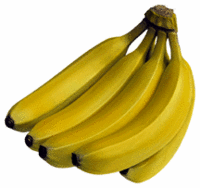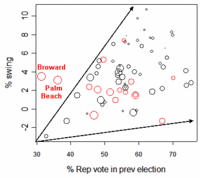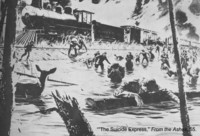 Yes, we will have no bananas, again:
Yes, we will have no bananas, again:
Most commercial growing facilities handle just a single banana type — the one we Americans slice into our morning cereal.
…
How much time is left for the Cavendish? Some scientists say five years;
some say 10. Others hold out hope that it will be much longer. Aguilar
has his own particular worst-case scenario, his own nightmare. "What
happens," he says, with a very intent look, "is that Panama disease
comes before we have a good replacement. What happens then," he says,
nearly shuddering in the shade of a towering banana plant, "is that
people change. To apples."
—Can This Fruit Be Saved?
By Dan Koeppel,
popsci.com,
June 2005
Cavendish is the variety of banana eaten the world around.
"Quite possibly the world’s perfect food," says Chiquita.
But perfection comes with a price if it leads to monoculture.
And that’s what we’ve got with bananas:
every commercial Cavendish banana tree is grown from cuttings
of the original tree, and so is genetically identical.
Banana monoculture has borne the fruit of disaster before.
Growers adopted a frenzied strategy of shifting crops to unused land,
maintaining the supply of bananas to the public but at great financial
and environmental expense — the tactic destroyed millions of acres of
rainforest. By 1960, the major importers were nearly bankrupt, and
the future of the fruit was in jeopardy. (Some of the shortages during
that time entered the fabric of popular culture; the 1923 musical hit
"Yes! We Have No Bananas" is said to have been written after songwriters
Frank Silver and Irving Cohn were denied in an attempt to purchase their
favorite fruit by a syntactically colorful, out-of-stock neighborhood
grocer.) U.S. banana executives were hesitant to recognize the crisis
facing the Gros Michel, according to John Soluri, a history professor
at Carnegie Mellon University and author of Banana Cultures, an upcoming
book on the fruit. "Many of them waited until the last minute."
Denial in the face of a clear and present ecological danger.
We’ve seen this before.
Continue reading →
 Well, it turns out we don’t have to
wait for the technology to be ready.
Florida is ditching all of its touch-screen voting machines
and moving to a proven technology:
Well, it turns out we don’t have to
wait for the technology to be ready.
Florida is ditching all of its touch-screen voting machines
and moving to a proven technology:








